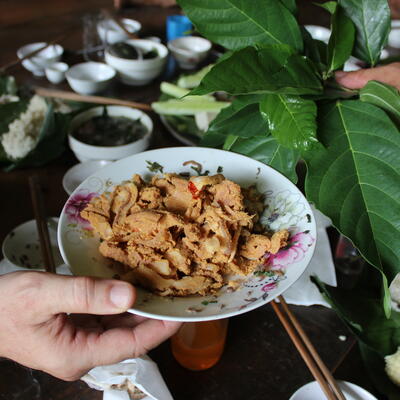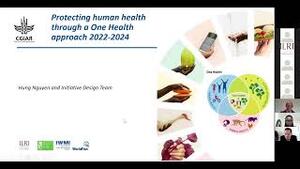
‘To turn the unknown into the known’: Inside the global effort to bring the fight to viruses
Dennis Carroll, chair of the Global Virome Project Leadership Board, an ambitious global effort to develop a comprehensive database of viruses and detect and track down the planet’s unknown and emerging viral threats, spoke with Jimmy Smith, the International Livestock Research Institute’s (ILRI) director general, at the institute’s weekly virtual meeting on 18 Nov 2020.
Carroll, who’s been dubbed ‘the man who saw the pandemic coming’ and featured in a Netflix special chronicling his decades-long work combating new disease threats at the US Agency for International Development (USAID) and the Centers for Disease Control (CDC), has known and worked with Smith since the early aughts, when Smith directed the World Bank’s response to the pathogenic avian influenza virus.
Dennis Carroll, the chair of the Global Virome Project Leadership Board, spoke at the institute’s weekly virtual meeting on 18 Nov 2020.
Carroll’s current project, as he puts it, is an effort to bring virus hunting into the twenty-first century. ‘We want to go from a “mom-and-pop” style operation, where you’re focused on a specific disease like Ebola, to a global partnership building a big data portal to understand viruses before they come to us.’
Throughout his discussion with Smith, Carroll tacked between describing the scale of the initiatives needed to counter the emergence of global pandemics and regretting the world’s failure to take the threat as seriously as it should have done. ‘Many of us understood that the emergence of a new viral threat was not a question of if, it was a question of when and where. And the emergency that is COVID-19 came as absolutely no surprise; its emergence, its spread—everything about it was very predictable.’
Smith asked what it felt like to have been warning about the possibility of a global pandemic for so long, only to see the situation unfold as it has. ‘What’s really shocking to me has less to do with the virus than with our response to the virus’, said Carroll. ‘We worked for nearly 20 years, since the emergence of SARS in 2003, to position the world to be better prepared. And the avian influenza of 2005–2006 further accelerated people’s awareness of and commitment to putting in place capacities and policies that could be drawn on in the case of a new pandemic. And yet what we’ve seen with COVID-19 is almost a global amnesia. You would never know that there had been 20 years of detailed planning and analysis into preventing and responding to these things.’
The Global Virome Project is in many ways a continuation and expansion of a project Carroll led for a decade at USAID called Project Predict. That project sought to quantify, for the first time, how many viruses are out there and how many might be harmful. ‘And we published a paper in Science, two years ago. There are about 1.5 million different viruses across 25 viral families. And of those, we estimate half a million to 600,000 have the potential to infect us, and a very small subset of those have the potential to have adverse effects.’
The Global Virome Project builds on Predict’s foundation, Carroll explained. ‘In Predict’s ten-year lifespan, they discovered and characterized about 1,200 new viruses—1,200 versus the 500,000 or so you really want to know about.’ This new project stands on the shoulders of Predict, said Carroll, but differs in two key ways.
First, it is a global venture that isn’t owned by USAID or the US government. That’s critical, said Carroll, because ‘to be able to effectively mount an effort to catalog and characterize and understand these future viral threats, and to translate that knowledge into policy and action, we need to have ownership of every country.’
In addition to its international orientation, the Global Virome Project (GVP) builds on continuing advances in computer processing. ‘So instead of knowing about a half dozen coronaviruses, we can begin to characterize and understand what we estimate to be about 4,000 different coronaviruses. We can do the same for the Filoviridae viruses, which is the viral family for Ebola. We can develop a deep database that allows us to run a genetic atlas on all of the viruses,’ said Carroll.
The advantage of this approach is clear: ‘So when we begin thinking about future counter measures, we’re not spending a billion dollars to develop a vaccine against a COVID-19 virus that ultimately has no efficacy against whatever that next coronavirus might be. You now have the ability to use machine learning to sweep across virtually all 4,000 of the coronaviruses and begin designing a broad-spectrum vaccine against the entire families of viruses.’
Carroll also noted that the GVP will collect a comprehensive data set on viral ecology—geographic location, host range, proximity to human populations—transforming our public health culture from one that responds to the latest outbreak, to one that is able to forecast future threats, prevent their emergence and spread among human and livestock populations, detect spillover events early when they do occur, and respond quickly to preempt their spread. This power to ‘prevent, detect, and respond’ will protect not only against human infections but also against infections of domesticated animals, which share our vulnerability to emerging viral threats. By extension, these measures should protect against devastating effects viral threats, such as the recent panzootics caused by the H5N1 highly pathogenic avian influenza and African swine fever in Asia, that have caused serious concerns regarding food security and livelihoods among poor farming communities of the world.
Smith asked Carroll whether the world is finally ready to provide the resources to projects like Carroll’s that are commensurate to the scale of the threat. He noted that when he was at the World Bank, the plans they developed to fight possible future pandemics never came to fruition; once the immediate threat passed, so too did possible funding.
Carroll agreed: ‘Like you, Jimmy, we have seen patterns of high levels of investment followed by severe contractions. There is a feast and famine, a war budget and a peace budget. And the war budget is when we’re in the middle of a pandemic or the threat of a pandemic. But once that battle is over or—more importantly—falls off the front pages of newspapers, sustaining the interest of governments and the private sector becomes an enormous challenge’.
Carroll is hopeful, however, that this time will be different. The scale of COVID-19, the depth of the health and economic harm it has caused, underline ‘how relatively small are the level of investments that need to be made to provide sustained support for prevention, for surveillance, for investing in the systems, to prevent future pandemics.’
But funding alone—no matter how generous—won’t be enough to fight the threat of future pandemics, Carroll added. Scientists, too, need to change their habitual ways of doing business. ‘Viruses move without hesitation from a bat to a pangolin, pig or human—they don’t care about species. But on the whole our sciences are stove-piped by species. And I would hope that not only do we get the sustained investments we need, but that we radically transform our vision of how we work across sectorial domains and create a truly unified partnership between human and animal health, including livestock and wildlife and the ecosystem.’
And indeed, that was Carroll’s final and most important point: For all the upside potential science holds to counter threats like global pandemics, the success of our efforts will ultimately come down to political and human factors. That means more than just continuing to fund research during ‘peacetime’ or deconstructing the stove pipes that limit scientific progress. It means being willing to submit to mild constraints on personal liberties in the interest of the common good, for example by wearing masks and practicing social distancing. ‘In some ways as a community, we have begun to fragment and not assume our responsibilities as members of a community. And I don’t think we’re ever going to get this right until we rebuild that sense of acting with the best interest of our neighbour at heart, and not simply in our own self-interest.’





















